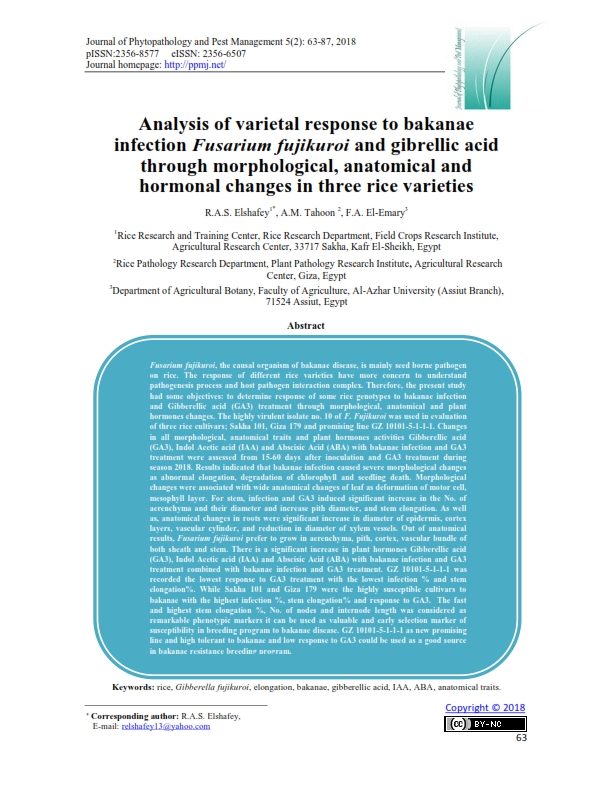Analysis of varietal response to bakanae infection Fusarium fujikuroi and gibberellic acid through morphological, anatomical and hormonal changes in three rice varieties
Keywords:
rice, Gibberella fujikuroi, elongation, bakanae, gibberellic acid, IAA, ABA, anatomical traits.Abstract
Fusarium fujikuroi, the causal organism of bakanae disease, is mainly seed borne pathogen on rice. The response of different rice varieties have more concern to understand pathogenesis process and host pathogen interaction complex. Therefore, the present study had some objectives: to determine response of some rice genotypes to bakanae infection and Gibberellic acid (GA3) treatment through morphological, anatomical and plant hormones changes. The highly virulent isolate no. 10 of F. Fujikuroi was used in evaluation of three rice cultivars; Sakha 101, Giza 179 and promising line GZ 10101-5-1-1-1. Changes in all morphological, anatomical traits and plant hormones activities Gibberellic acid (GA3), Indol Acetic acid (IAA) and Abscisic Acid (ABA) with bakanae infection and GA3 treatment were assessed from 15-60 days after inoculation and GA3 treatment during season 2018. Results indicated that bakanae infection caused severe morphological changes as abnormal elongation, degradation of chlorophyll and seedling death. Morphological changes were associated with wide anatomical changes of leaf as deformation of motor cell, mesophyll layer. For stem, infection and GA3 induced significant increase in the No. of aerenchyma and their diameter and increase pith diameter, and stem elongation. As well as, anatomical changes in roots were significant increase in diameter of epidermis, cortex layers, vascular cylinder, and reduction in diameter of xylem vessels. Out of anatomical results, Fusarium fujikuroi prefer to grow in aerenchyma, pith, cortex, vascular bundle of both sheath and stem. There is a significant increase in plant hormones Gibberellic acid (GA3), Indol Acetic acid (IAA) and Abscisic Acid (ABA) with bakanae infection and GA3 treatment combined with bakanae infection and GA3 treatment. GZ 10101-5-1-1-1 was recorded the lowest response to GA3 treatment with the lowest infection % and stem elongation%. While Sakha 101 and Giza 179 were the highly susceptible cultivars to bakanae with the highest infection %, stem elongation% and response to GA3. Â The fast and highest stem elongation %, No. of nodes and internode length was considered as remarkable phenotypic markers it can be used as valuable and early selection marker of susceptibility in breeding program to bakanae disease. GZ 10101-5-1-1-1 as new promising line and high tolerant to bakanae and low response to GA3 could be used as a good source in bakanae resistance breeding program. Â
Metrics

Published
How to Cite
Issue
Section
License
Authors who publish with Journal of Phytopathology and Disease Management agree to the following terms:
- Authors retain copyright and grant the journal right of first publication with the work simultaneously licensed under a Creative Commons Attribution License that allows others to share the work with an acknowledgement of the work's authorship and initial publication in this journal.
- Authors retain copyright and grant the journal right of first publication with the work simultaneously licensed under the Creative Commons Attribution-Non Commercial License (CC BY-NC). This allows others to share the work with an acknowledgement of the work's authorship and initial publication in this journal.
- Archives of Agricultural Sciences Journal is an Open Access Journal, and articles published are distributed under the terms of the Creative Commons Attribution-Non Commercial License (CC BY-NC). Readers may copy, distribute, and display the work for non commercial purposes with the proper citation of the original work. However, the journal retains the right to exploit subsidiary rights on behalf of the authors.
- Authors are able to enter into separate, additional contractural arrangements for the non-exclusive distribution of the journal's published version of the work (e.g. post it to an institutional repository or publish it in a book), with an acknowledgement of its initial publication in this journal.
- Authors are permitted and encouraged to post their work online (e.g., in institutional repositories or on their website) prior to and during the submission process with full disclosure to the journal, as it can lead to productive exchanges, as well as earlier and greater citation of published work. Following publication in Archives of Agricultural Sciences Journal, the author should update the repository, and include a citation and link to the published work.
Click here for more information on Licensing policy
.png)




